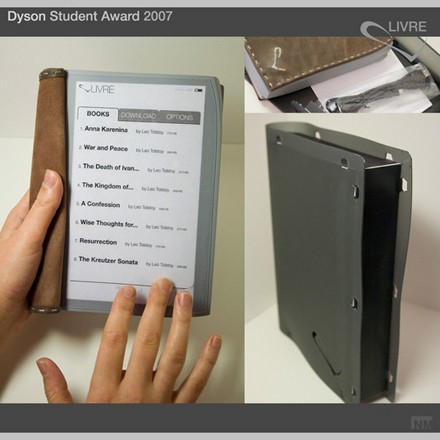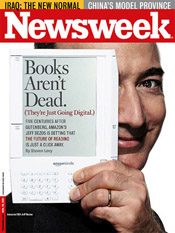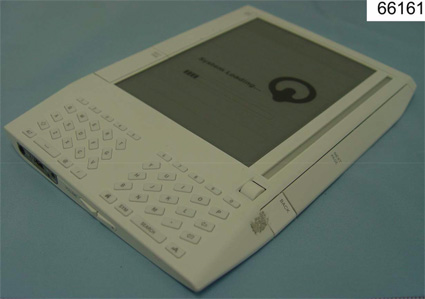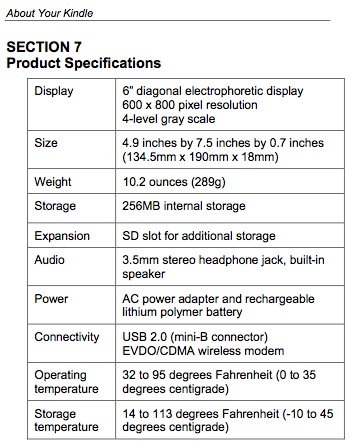Engagdet points to an award winning Australian student design for an e-book reader that combines the gesture-based “multi-touch” interface of the iPhone with the e-ink display of the Kindle.

LIVRE design concept -? Nedzad Mujcinovic, Monash University
“Interaction happens via a thin capacitive touch screen mounted on top of an electronic paper screen (‘eINK’). Browsing pages happens by striking the screen from right bottom corner towards the centre of page to go forward or from the left hand corner to go backwards. Doing that using one finger will browse one page, two will browse ten pages and three will browse fifty pages at a time.”
If simple reenactment of basic black-and-white, illustration-light print reading is your goal, I’d say that this is a far more viable proposition than Amazon’s clunky gadget. (Thanks, Peter Brantley, for the link!)
Category Archives: kindle
the future of the sustainable book
On New Year’s Eve, I got lost in Yonkers trying to take my son’s gently-used toys to the Salvation Army. The Yonkers store was the only one I could find willing to take them. The guy on the phone hesitated, “Are they in good condition?” he asked, clearly unhappy about my impending donation. I assured him they were, and he sighed and told me to come on over.
On principle, I try (really hard) to give away anything that is not completely worn out. But it is getting harder and harder to do. Nobody wants my old furniture or clothes or books. And they especially don’t want used children’s toys. My attempt to give them away was ill-fated. A police barricade stopped me at Nepperhan Avenue (a construction site disaster). Then I drove around for forty minutes until I found an alternate route but was twarted at Ashburton Ave (building on fire, streets blocked). I gave up and went home. With stomach full of guilt, I put the plastic toys in the dumpster. My son didn’t mind because he had a brand new pile of toys in his playroom, Christmas gifts from relatives and friends who couldn’t be dissuaded.
Point is, it seems increasingly difficult to opt out of the cycle of waste-creation. Plastic kids’ toys are just one example. I’m also guilty of consuming and transforming lots of other things into waste: clothes, computers, cell phones, magazines, all sorts of complicatedly-packaged food and beverage items, etc… So yesterday, when I contemplated how best to spend 2008, I decided to focus on figuring out how to create a more sustainable lifestyle. And since I work in book publishing, job one is to figure out what it means to create a sustainable book. Lots of models come to mind. Good ones like Wikipedia (device-neutral and always in the latest, free, edition) and bad ones like the Kindle, (which tries to create a market for an ebook reader with designed obsolescence).
Anyway, I thought it might be useful to weave the sustainability discussion into if:book’s ongoing consideration of networked ebooks, because at this stage in their developement, networked books could be shaped with sustainability in mind. So, I’m hoping to stir up some interesting discussion and serious contemplation of the perfectly sustainable book: one that is constantly revised, but never needs to be reprinted (or repurchased); one that is lean and simple and doesn’t require a small server farm or a special device; one that makes an enormous impact, but leaves a teeny tiny carbon footprint; one we can live with for ever and ever without getting bored or satiated.
kindle maths 101
Chatting with someone from Random House’s digital division on the day of the Kindle release, I suggested that dramatic price cuts on e-editions -? in other words, finally acknowledging that digital copies aren’t worth as much (especially when they come corseted in DRM) as physical hard copies -? might be the crucial adjustment needed to at last blow open the digital book market. It seemed like a no-brainer to me that Amazon was charging way too much for its e-books (not to mention the Kindle itself). But upon closer inspection, it clearly doesn’t add up that way. Tim O’Reilly explains why:
…the idea that there’s sufficient unmet demand to justify radical price cuts is totally wrongheaded. Unlike music, which is quickly consumed (a song takes 3 to 4 minutes to listen to, and price elasticity does have an impact on whether you try a new song or listen to an old one again), many types of books require a substantial time commitment, and having more books available more cheaply doesn’t mean any more books read. Regular readers already often have huge piles of unread books, as we end up buying more than we have time for. Time, not price, is the limiting factor.
Even assuming the rosiest of scenarios, Kindle readers are going to be a subset of an already limited audience for books. Unless some hitherto untapped reader demographic comes out of the woodwork, gets excited about e-books, buys Kindles, and then significantly surpasses the average human capacity for book consumption, I fail to see how enough books could be sold to recoup costs and still keep prices low. And without lower prices, I don’t see a huge number of people going the Kindle route in the first place. And there’s the rub.
Even if you were to go as far as selling books like songs on iTunes at 99 cents a pop, it seems highly unlikely that people would be induced to buy a significantly greater number of books than they already are. There’s only so much a person can read. The iPod solved a problem for music listeners: carrying around all that music to play on your Disc or Walkman was a major pain. So a hard drive with earphones made a great deal of sense. It shouldn’t be assumed that readers have the same problem (spine-crushing textbook-stuffed backpacks notwithstanding). Do we really need an iPod for books?
UPDATE: Through subsequent discussion both here and off the blog, I’ve since come around 360 back to my original hunch. See comment.
We might, maybe (putting aside for the moment objections to the ultra-proprietary nature of the Kindle), if Amazon were to abandon the per copy idea altogether and go for a subscription model. (I’m just thinking out loud here -? tell me how you’d adjust this.) Let’s say 40 bucks a month for full online access to the entire Amazon digital library, along with every major newspaper, magazine and blog. You’d have the basic cable option: all books accessible and searchable in full, as well as popular feedback functions like reviews and Listmania. If you want to mark a book up, share notes with other readers, clip quotes, save an offline copy, you could go “premium” for a buck or two per title (not unlike the current Upgrade option, although cheaper). Certain blockbuster titles or fancy multimedia pieces (once the Kindle’s screen improves) might be premium access only -? like HBO or Showtime. Amazon could market other services such as book groups, networked classroom editions, book disaggregation for custom assembled print-on-demand editions or course packs.
This approach reconceives books as services, or channels, rather than as objects. The Kindle would be a gateway into a vast library that you can roam about freely, with access not only to books but to all the useful contextual material contributed by readers. Piracy isn’t a problem since the system is totally locked down and you can only access it on a Kindle through Amazon’s Whispernet. Revenues could be shared with publishers proportionately to traffic on individual titles. DRM and all the other insults that go hand in hand with trying to manage digital media like physical objects simply melt away.
* * * * *
On a related note, Nick Carr talks about how the Kindle, despite its many flaws, suggests a post-Web2.0 paradigm for hardware:
If the Kindle is flawed as a window onto literature, it offers a pretty clear view onto the future of appliances. It shows that we’re rapidly approaching the time when centrally stored and managed software and data are seamlessly integrated into consumer appliances – all sorts of appliances.
The problem with “Web 2.0,” as a concept, is that it constrains innovation by perpetuating the assumption that the web is accessed through computing devices, whether PCs or smartphones or game consoles. As broadband, storage, and computing get ever cheaper, that assumption will be rendered obsolete. The internet won’t be so much a destination as a feature, incorporated into all sorts of different goods in all sorts of different ways. The next great wave in internet innovation, in other words, won’t be about creating sites on the World Wide Web; it will be about figuring out creative ways to deploy the capabilities of the World Wide Computer through both traditional and new physical products, with, from the user’s point of view, “no computer or special software required.”
That the Kindle even suggests these ideas signals a major advance over its competitors -? the doomed Sony Reader and the parade of failed devices that came before. What Amazon ought to be shooting for, however, (and almost is) is not an iPod for reading -? a digital knapsack stuffed with individual e-books -? but rather an interface to a networked library.
amazon raises paperback prices
An interesting twist in the Kindle story reported at Dear Author:
Amazon’s pricing for mass market books has suddenly gone full retail, no discount since the release of the Kindle. When questioned in Newsweek about the low pricing, Bezos said “low-margin and high-volume sale – ?you just have to make sure the mix [between discounted and higher-priced items] works.” It looks like Bezos is hoping to make more money off the high volume of sales from those mass market purchasers.
…I guess this is one way of forcing readers to purchase the Kindle. If Kindle success rises or falls on the backs of the mass market purchasers, this is going to be ugly because I see a whole bunch of Amazon purchasers being pretty upset about this turn of events.
Thanks to Peter Brantley for the link.
of razors and blades
A flurry of reactions to the Amazon Kindle release, much of it tipping negative (though interestingly largely by folks who haven’t yet handled the thing).
David Rothman exhaustively covers the DRM/e-book standards angle and is generally displeased:
I think publishers should lay down the law and threaten Amazon CEO Jeff Bezos with slow dismemberment if he fails to promise immediately that the Kindle will do .epub [the International Digital Publishing Forum’s new standard format] in the next six months or so. Epub, epub, epub, Jeff. Publishers still remember how you forced them to abandon PDF in favor of your proprietary Mobi format, at least in Amazon-related deals. You owe ’em one.
Dear Author also laments the DRM situation as well as the jacked-up price:
Here’s the one way I think the Kindle will succeed with consumers (non business consumers). It chooses to employ a subscription program whereby you agree to buy x amount of books at Amazon in exchange for getting the Kindle at some reduced price. Another way to drive ereading traffic to Amazon would be to sell books without DRM. Jeff Bezos was convinced that DRM free music was imperative. Why not DRM free ebooks?
There are also, as of this writing, 128 customer reviews on the actual Amazon site. One of the top-rated ones makes a clever, if obvious, remark on Amazon’s misguided pricing:
The product is interesting but extremely overpriced, especially considering that I still have to pay for books. Amazon needs to discover what Gillette figured out decades ago: Give away the razor, charge for the razor blades. In this model, every Joe gets a razor because he has nothing to lose. Then he discovers that he LOVES the razor, and to continue loving it he needs to buy razors for it. The rest is history.
This e-book device should be almost free, like $30. If that were the case I’d have one tomorrow. Then I’d buy a book for it and see how I like it. If I fall in love with it, then I’ll continue buying books, to Amazon’s benefit.
There is no way I’m taking a chance on a $400 dedicated e-book reader. That puts WAY too much risk on my side of the equation.
newsweek covers the future of reading
 Steven Levy’s Newsweek cover story, “The Future of Reading,” is pegged to the much anticipated release of the Kindle, Amazon’s new e-book reader. While covering a lot of ground, from publishing industry anxieties, to mass digitization, Google, and speculations on longer-term changes to the nature of reading and writing (including a few remarks from us), the bulk of the article is spent pondering the implications of this latest entrant to the charred battlefield of ill-conceived gadgetry which has tried and failed for more than a decade to beat the paper book at its own game. The Kindle has a few very significant new things going for it, mainly an Internet connection and integration with the world’s largest online bookseller, and Jeff Bezos is betting that it might finally strike the balance required to attract larger numbers of readers: doing a respectable job of recreating the print experience while opening up a wide range of digital affordances.
Steven Levy’s Newsweek cover story, “The Future of Reading,” is pegged to the much anticipated release of the Kindle, Amazon’s new e-book reader. While covering a lot of ground, from publishing industry anxieties, to mass digitization, Google, and speculations on longer-term changes to the nature of reading and writing (including a few remarks from us), the bulk of the article is spent pondering the implications of this latest entrant to the charred battlefield of ill-conceived gadgetry which has tried and failed for more than a decade to beat the paper book at its own game. The Kindle has a few very significant new things going for it, mainly an Internet connection and integration with the world’s largest online bookseller, and Jeff Bezos is betting that it might finally strike the balance required to attract larger numbers of readers: doing a respectable job of recreating the print experience while opening up a wide range of digital affordances.
Speaking of that elusive balance, the bit of the article that most stood out for me was this decidely ambivalent passage on losing the “boundedness” of books:
Though the Kindle is at heart a reading machine made by a bookseller – ?and works most impressively when you are buying a book or reading it – ?it is also something more: a perpetually connected Internet device. A few twitches of the fingers and that zoned-in connection between your mind and an author’s machinations can be interrupted – ?or enhanced – ?by an avalanche of data. Therein lies the disruptive nature of the Amazon Kindle. It’s the first “always-on” book.
amazon looks to “kindle” appetite for ebooks with new device

Engadget has uncovered details about a soon-to-be-released upcoming/old/bogus(?) Amazon ebook reading device called the “Kindle,” which appears to have an e-ink display, and will presumably compete with the Sony Reader. From the basic specs they’ve posted, it looks like Kindle wins: it’s got more memory, it’s got a keyboard, and it can connect to the network (update: though only through the EV-DO wireless standard, which connects Blackberries and some cellphones; in other words, no basic wifi). This is all assuming that the thing actually exists, which we can’t verify.

Regardless, it seems the history of specialized ebook devices is doomed to repeat itself. Better displays (and e-ink is still a few years away from being really good) and more sophisticated content delivery won’t, in my opinion, make these machines much more successful than their discontinued forebears like the Gemstar or the eBookMan.
Ebooks, at least the kind Sony and Amazon will be selling, dwell in a no man’s land of misbegotten media forms: pale simulations of print that harness few of the possibilities of the digital (apparently, the Sony Reader won’t even have searchable text!). Add highly restrictive DRM and vendor lock-in through the proprietary formats and vendor sites made for these devices and you’ve got something truly depressing.
Publishers need to get out of this rut. The future is in networked text, multimedia and print on demand. Ebooks and their specialized hardware are a red herring.
Teleread also comments.
